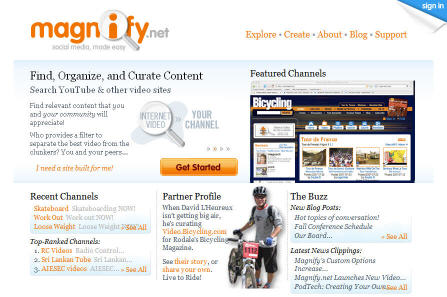-
An Intersection of UGC and Brand Marketing?
(Quick correction - there was a technical problem with the link in yesterday's email to register for the Feb. 28th webinar. The correct link to register is here).
Lately I've been thinking a lot about where there may be potential points of intersection between user-generated video and brand marketing.
On the one hand, YouTube and others have demonstrated there's huge interest among amateur producers in creating and posting video content. Since the overwhelming majority of these producers do not make any meaningful money from these videos, their motivation is emotional. On the other hand, brands are grappling with things like how to break through the clutter, deepen consumer engagement, create more authenticity and build loyalty.
So it seems like there should be a natural point of intersection if brands could incent their passionate customers to create videos which not only sang the praises of their favorite products but actually provided valuable information sought by other prospective customers. Offering these videos would enable customers to show off their favorite products in action and also provide a valuable service to prospects. The concept is sort of like a video-based TripAdvisor, but not limited to travel.
Here's an example from a personal experience. Recently I've been in the market for a 50+ inch HDTV. If you've been in this mode recently you know the drill - lots of online research, reading users' comments, going to stores to see different models, etc. Even after doing all this, I still felt like I was missing something. I really wanted to see the intangibles - what distance seemed right, what's the right height for the stand, what were the ambient issues, how were accessories connected and so on.
In short, I was looking for actual owners to provide short, but informative videos showcasing how the TV actually worked out when brought into their homes. To be sure, there's no shortage of text comments to this effect. But the best I could find beyond text was a link at Amazon to "Share your own customer images." It seems like such a natural to me that online retailers, review sites and TV manufacturers should all provide a user-generated video platform for consumers to upload videos providing further information on their TVs.
What I'm describing is not another brand-sponsored UGC contest, but rather solid consumer-contributed product information. T-Mobile has something like this running with Current TV right now, but seems to really be the exception. I looked at the web sites of Sony, Samsung, Panasonic, Sharp, Philips and Mitsubishi and, although in some cases there are buying guides and FAQs, none of them seek to harness the enthusiasm of their actual customers by enabling video contributions.
Maybe I'm missing something, but I think this is a big untapped opportunity. I know companies like ViTrue and StashCast are pursuing opportunities like this, and then there are countless private label social network platforms like KickApps, Ning and others (TechCrunch has a good list here) that also enable some flavor of this. But I just haven't seen this concept clearly or pervasively implemented yet. If you have, please post a comment. I just have to believe that some smart brands - particularly those selling complex, expensive products that benefit from video-based information - are going to realize their passionate customers are incredible assets just waiting to be empowered to speak out through user-generated video.
Categories: Brand Marketing, UGC
Topics: Amazon, Current TV, KickApps, Ning, Stashcast, T-Mobile, ViTrue
-
Magnify.net: A Long Tail Matchmaker
 Yesterday I had a chance to catch up with Steve Rosenbaum, CEO and Co-Founder of Magnify.net.
Yesterday I had a chance to catch up with Steve Rosenbaum, CEO and Co-Founder of Magnify.net.One of the things I really enjoy about being an analyst in the burgeoning broadband video industry is getting first-hand exposure to all the clever innovation that's going on. I find it endlessly fascinating to hear directly from entrepreneurs on the front lines where the kernel of their idea came from which led to their business plan. A user experience issue? A technology deficiency? A business model flaw? Over the years I've heard many stories. Some kernels have real weight, while some don't quite resonate for me.
Magnify.net falls into the former category. My read is that this is a company trying to solve a real problem with a very clever solution and the right "corporate attitude" to make it a likely winner.
Magnify is actually solving a number of real problems, many of which relate to the highly distributed or "Long Tail" nature of the Internet and broadband video. First is that while consumers love broadband video, finding what they want is problematic. Novelty quickly turns to frustration when rummaging through big video sharing sites to find something relevant. No matter how much users want choice, some level of editorial or "curation" is essential to optimize their experience.
Magnify enables existing enthusiast or vertical web sites (whether independent or major media) to obtain video from the best video sharing sites (YouTube, Metacafe, etc.) and coherently present a screened assortment to their users. The sites' use their editorial skills to sort the wheat from the chafe, with easy-to-use admin tools ensuring that no offending video slips through the cracks.
So the second problem Magnify solves is enabling thousands (17,500 and counting to be exact) of sites to provide quality video to their users without the hassle and expense of creating it themselves (the "matchmaker" role). These sites get 50% of the revenue from the ads Magnify sells around the video (or they can keep up to 50% of the inventory to sell themselves), leveraging their audience and subject matter expertise. Incorporating video into web sites is becoming online table stakes. I agree with Steve, in the years ahead, sites without video are going to look "charming".
The only real hole I can find in Magnify's model is that it doesn't currently compensate the content creators themselves (a la Revver for example). However I'd expect that to change as creators upload directly to Magnify and the company's network and traffic builds out over time.
Lastly, I like Steve's attitude. He views the market as an incredibly expanding pie, and not "winner take all." As a result, while there are others who touch on Magnify's space (Brightcove, ROO, VideoEgg, Ning, KickApps, etc.), he's less concerned about competition per se and matching feature-for-feature, but rather on responding to the needs and wants expressed directly by their own user base. Companies that do this ultimately win, regardless of competition.
The Magnify story plays into a number of areas I follow closely - the changing role and power of video distributors, the continued "nichification" of video, the challenge of video discovery and the reliance on ads, not subscription fees. To the extent that their approach succeeds it will further morph traditional video models. For a 10 person company that's only done an angel round, they've accomplished a lot in addressing genuine Long Tail issues in the broadband video industry. (Btw, TechCrunch has 2 great reviews, here and here).
Categories: Aggregators, Indie Video, Startups, UGC, Video Sharing
Topics: Brightcove, KickApps, Magnify.net, Ning, ROO, VideoEgg
Posts for 'Ning'
|


